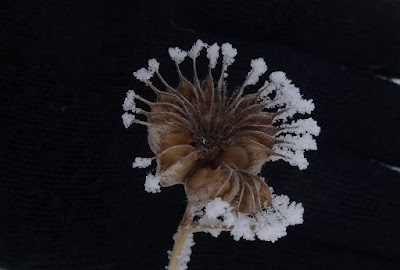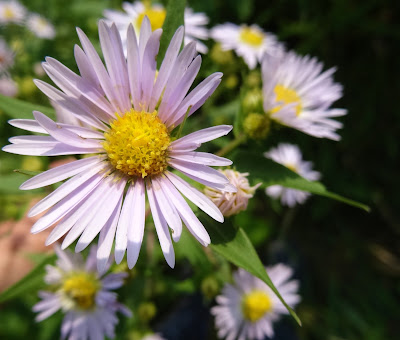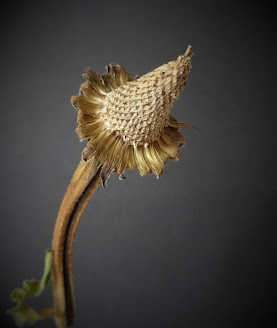8/13/2021
7/02/2021
3/24/2021
junco in spring
2/01/2021
1/10/2021
velvetleaf
Many plants, which bloom and fruit in the warm growing season, stand bravely throughout the winter to ensure its seeds are fully distributed. This fruit capsule opened as it dried out in Autumn, and seeds have been coaxed out by the breeze. Now, it stands despite snow and hoarfrost.
Velvetleaf Abutilon theophrasti blooms in late summer with orange-yellow flowers on stems and leaves that really look and feel like they are cloaked in velvet. There were a few growing in the riparian buffer around the pond, but we pulled them because this plant is not native. It can form dense monocultures in place of native plants, suck large quantities of water and nutrients from the soil, and can inhibit germination of other plants.This in one of the plants that probably spreads from nearby crop fields, and that we try to keep out of the pond area.
9/24/2020
lavender asters
Asters in the Symphyotrichum genus may be blue, lavender, or white, and many shades of those colors. These lavender flowers, blooming now in the buffer around the pond, are one of approximately 25 aster plants native to Minnesota. Some of them provide food for bees and other insects through the late summer season.
9/17/2020
lobelia still vibrant

9/09/2020
grasshopper on coneflower
On the blooming coneflowers, a Two-striped Grasshopper Melanoplus bivittatus rests in the sunshine. This grasshopper usually lives in sunny, moist, lush, weedy or meadow areas -- like the wetland around the pond. They eat a wide variety of plants, and sometimes also dead animal matter on the ground. They require unsaturated fatty acids in their diet since these nutrients help keep their wings strong and rigid.
8/17/2020
Coneflower seed harvest
It is time to harvest some wildflower seeds, in order to expand the native plant population in the riparian buffer surrounding our pond. There are more than 30 documented native species in this buffer. Close to the water is a ring of wetland; outside of that is a ring of moist to dry areas. So the pond provides a comfortable home for a wide variety of plants. We hope to reduce the 'weeds' and encourage the flowering native plants to flourish.
For example, a few coneflowers bloom here. Purple Coneflower Echinacea purpurea now has some blooms 'going to seed' as the petals dry out. When I remove the seeds, intending to spread them around the pond for new plants, we can see why this plant is called 'cone flower'.
8/01/2020
protecting native plants
7/23/2020
horsetail
7/12/2020
Mountain Mint blooming
Blooming now in the riparian buffer around the pond - - Virginia Mountain Mint, Pycnanthemum virginianum. Look for them as 2 or 3 foot tall bushy plants. Because the individual flowers are tiny, this plant is an important food for short-tongued bees. They can reach into the flowers easily to drink the nectar. In the photo above, you can see the clusters of tiny white flowers with delicate purple spots. The flowers open one at a time, providing nectar over many days.
Below, this subtle plant grows among yellow Birdsfoot Trefoil and daisy-like Fleabane.














